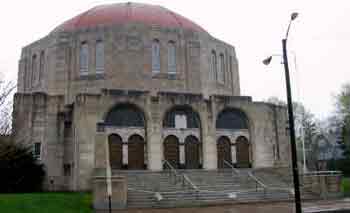Historic Synagogues of Connecticut
The Historic Synagogues of Connecticut were built to meet the religious and social needs of Jewish immigrants from Europe. The first Jewish people to arrive in Connecticut in significant numbers were from Germany, arriving in the mid-19th century. At the end of the 19th century, greater numbers of Eastern European Jewish immigrants came to Connecticut.
Early in the English settlement of Connecticut each community established the Congregational Church, which was supported by tax revenues. Other Christian denominations such as the Baptist, Methodist, and Episcopal churches gained a foothold in the state, but were in a distinct minority while non-Christian centers of worship were unknown. In 1818 a constitutional convention in Connecticut resulted in the disestablishment of the Congregational Church as a tax-supported institution. At this time less than a dozen people of the Jewish faith were known to live in Connecticut. Jewish public worship was not permitted in Connecticut until 1843. When the Connecticut General Assembly responded to a petition from the growing Jewish population by enacting Chapter XXXIX of the Connecticut General Statues. The chapter read, in part, “That Jews who may desire to unite and form religious societies, shall have the same rights, powers and privileges which are given to Christians of every denomination.”
Services were first held in private homes or in rented halls. The first synagogues were usually churches adapted as synagogues.
The Historic Synagogues of Connecticut fall into three broad categories. The largest number of synagogues listed in the National Register from Connecticut are buildings constructed as synagogues in urban locations, followed by buildings constructed as synagogues in non-urban locations, and, lastly, buildings, usually churches, constructed for another purpose which were adapted as synagogue.
Urban Connecticut Synagogues
The Historic Synagogues of Connecticut Multiple Property Submission includes a total of 12 urban synagogues. The design of the synagogues, from Temple Beth Israel in Hartford (1876), to Rodeph Shalom, Bridgeport (1947), reflect a variety of architectural styles, including that of the traditional iconic Oranienburgerstrasse synagogue in Berlin, Germany and the Bauhaus.
• Temple Beth Israel: The congregation of Temple Beth Israel moved from their original location in Hartford to West Hartford in 1933. Not many Byzantine domes, widely popular elsewhere, are seen in historic Connecticut synagogues, but the Byzantine style is fully developed at Temple Beth Israel in West Hartford. Temple Beth Israel is a large two-story limestone structure, built in the shape of a 12-sided polygon, symbolic of the 12 tribes of Israel.
• West End Congregation/Achavath Achim Synagogue: In an entirely different mode, architect Leonard Asheim gave West End Congregation/Achavath Achim Synagogue in Bridgeport, completed in 1926, a Colonial Revival and Georgian Revival building based on the Federal period (1780 -1830.) The design included Colonial Revival motifs of two-story attenuated columns with corn-husk capitals supporting a classic pediment. Behind the columns a tall Federal doorway leads to the sanctuary. The Flemish bond of the brick walls and the lantern at the apex of the main roof gable complete the Georgian Revival elements.
• Rodeph Sholom Synagogue and Talmud Torah: Rodeph Sholom in Bridgeport, was constructed in 1947 by Jesse James Hamblin. It was built of red brick with limestone trim and combines a monumental classical entry façade with the massing and flat ornamentation of the Art Deco. Broad doors lead up to triple doorways separated by slender Doric columns and flanked by rusticated piers.
Non-urban Connecticut Synagogues
While most historic Connecticut synagogues are in urban locations, some are in non-urban country and resort communities. These synagogues reflect the need of Jewish farming and summer congregations for buildings suitable for worship that were within their limited financial and geographic boundaries. These were usually modest buildings recognizable as synagogues primarily by symbols such as the Magen David and Declogue often mounted near the doorway.
• Anshei Israel Synagogue, Lisbon, was built in 1936 in the Colonial Revival style and is an excellent example of a small country Jewish house of worship. The architecture is the epitome of simplicity, but, due to its tall projecting tower, undeniably in the Colonial Revival tradition.
• Knesseth Israel Synagogue, Ellington, was built in 1913 by an Orthodox congregation and moved in 1954 to its present location, and is also Colonial Revival in style.
• The Hebrew Congregation of Woodmont, Milford is a resort synagogue along the shore of Long Island Sound. A modest frame structure in the Colonial Revival style, with a larger community hall next door, the synagogue is in an excellent state of preservation.
Synagogues adapted from other buildings:
In the late 19th and early 20th century, it was not unusual for a church to be adaptively reused as a synagogue. The Historic Synagogues of Connecticut Multiple Property Submission includes a total of four synagogues that have been adapted for synagogue use, inlcuding
• Bikur Cholim Synagogue, in Bridgeport was constructed around 1894 in the Shingle style, as the Iranistan Avenue mission of the South Congregational Church. After serving this purpose until 1907, the church was acquired briefly by the First Christian Church (Christ’s Disciples), a congregation formed in 1907 and disbanded in 1914. Congregation Rodeph Sholom, Conservative, formed in 1909, occupied the premises from about 1923 to 1949, when it moved to Park Avenue. The Orthodox Congregation Bikur Cholim occupied the property until 1989, when the building was converted to a shop.
Sources: National Park Service; Photo courtesy of Jewish Buffalo |
